Magnetic field in the Arctic regions
Although almost 90% of the observed magnetic field can be approximated by a dipole, the 10% left over, called the non-dipole field cannot be ignored. In places it can be large relative to the dipole field, thus altering noticeably the shape of the observed field. This is especially true in the vicinity of the North Magnetic Pole, with important consequences. In order to appreciate how the non-dipole part of the magnetic field distorts the overall shape of the magnetic field it is important to understand what the dipole field looks like. The three diagrams illustrate the following points.
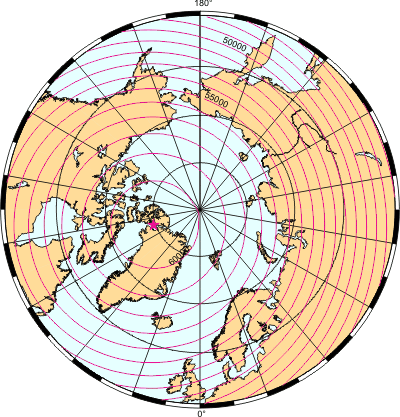
Total intensity of the Dipole Field
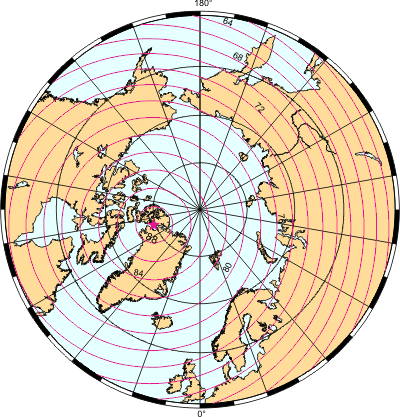
Inclination of the Dipole Field
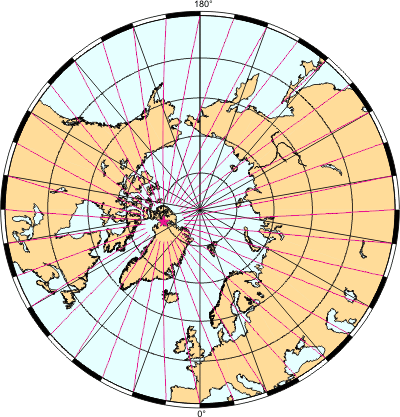
Magnetic Meridians for the Dipole Field
- The dipole field is symmetrical around the magnetic poles.
- Lines of inclination form circles around the magnetic poles.
- The strength of a dipole field is maximum at the magnetic poles. The strength at the poles is twice the strength of the field at the equator.
- Magnetic meridians converge radially on the north magnetic pole; in other words, a compass needle will point directly at the north magnetic pole.
The real magnetic field is quite different, as can be seen in the next set of three diagrams.
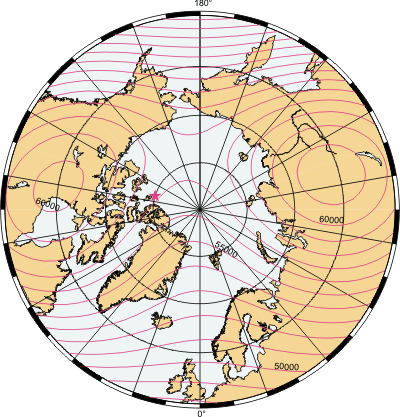
Total Intensity

Inclination
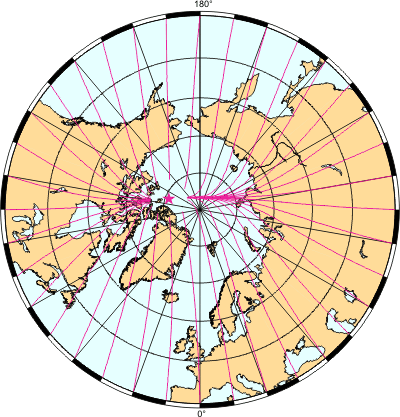
Magnetic Meridians
- The observed magnetic field is highly asymmetrical.
- Lines of inclination are highly elliptical, with the North Magnetic Pole situated near one end of the ellipse.
- The strength of the magnetic field is no longer a maximum at the North Magnetic Pole. In fact, there are now two maxima, one over central Canada, the other over Siberia.
- Magnetic meridians do not converge radially on the North Magnetic Pole.
This final point needs further explanation. Contrary to popular belief, a compass needle does not point directly at the North Magnetic Pole. However, if a traveller sets out from some location and proceeds in the direction in which his or her compass needle points, he or she will eventually reach the North Magnetic Pole, but by a route that will not be direct. The accompanying diagram shows clearly that the magnetic meridians (red) diverge considerably from the direct path to the Magnetic Pole (green). The European example is particularly striking. Although the direct path to the Magnetic Pole requires a traveller setting out from southern Europe, at the edge of the map, to head 8 degrees west of north, a compass will lead the traveller almost 3 degrees east of north. By the time the traveller reaches Scandinavia he or she is over 18 degrees off course, and at 80 N, almost 46 degrees of course. The compass will lead the traveller past the geographic pole on the wrong (i.e. Siberian) side before it makes a sharp left turn towards the North Magnetic Pole.

Magnetic meridians diverge from the direct path to the Magnetic Pole
Magnetic meridians should not be confused with magnetic declination. Declination is actually the angle between the magnetic meridian and the geographic meridian (true north) at a given location. Declination can vary considerably along a magnetic meridian.
Another common misconception is that the North Magnetic Pole is an "attractive" pole; that is, it attracts a compass needle towards it. In reality, the magnetic field felt by a compass needle is essentially uniform over the length of a compass needle and as a result the net force on the needle is zero. This means that the needle is not "pulled" towards either Magnetic Pole. However, because the compass needle is a small dipole with opposite polarity at either end, the northward directed magnetic field of the earth will cause the needle to rotate until it is aligned in the local direction of the magnetic field.